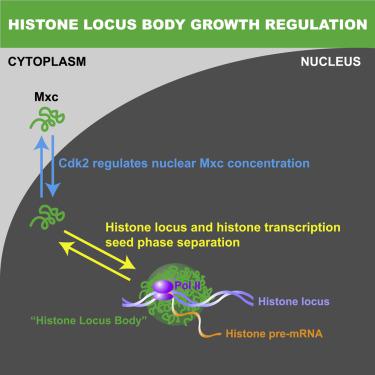Developmental Cell ( IF 10.7 ) Pub Date : 2020-06-23 , DOI: 10.1016/j.devcel.2020.06.003 Woonyung Hur 1 , James P Kemp 2 , Marco Tarzia 3 , Victoria E Deneke 1 , William F Marzluff 4 , Robert J Duronio 5 , Stefano Di Talia 1

|
Many membraneless organelles form through liquid-liquid phase separation, but how their size is controlled and whether size is linked to function remain poorly understood. The histone locus body (HLB) is an evolutionarily conserved nuclear body that regulates the transcription and processing of histone mRNAs. Here, we show that Drosophila HLBs form through phase separation. During embryogenesis, the size of HLBs is controlled in a precise and dynamic manner that is dependent on the cell cycle and zygotic histone gene activation. Control of HLB growth is achieved by a mechanism integrating nascent mRNAs at the histone locus, which facilitates phase separation, and the nuclear concentration of the scaffold protein multi-sex combs (Mxc), which is controlled by the activity of cyclin-dependent kinases. Reduced Cdk2 activity results in smaller HLBs and the appearance of nascent, misprocessed histone mRNAs. Thus, our experiments identify a mechanism linking nuclear body growth and size with gene expression.
中文翻译:

由组蛋白基因接种的 CDK 调节相分离确保组蛋白基因座体的精确生长和功能。
许多无膜细胞器通过液-液相分离形成,但它们的大小如何控制以及大小是否与功能相关仍知之甚少。组蛋白基因座体 (HLB) 是一种进化上保守的核体,可调节组蛋白 mRNA 的转录和加工。在这里,我们表明果蝇HLB 通过相分离形成。在胚胎发生过程中,HLB 的大小以精确和动态的方式受到控制,这取决于细胞周期和合子组蛋白基因的激活。HLB 生长的控制是通过在组蛋白基因座处整合新生 mRNA 的机制实现的,这有助于相分离,以及支架蛋白多性梳 (Mxc) 的核浓度,由细胞周期蛋白依赖性激酶的活性控制。降低的 Cdk2 活性导致更小的 HLB 和新生的、错误加工的组蛋白 mRNA 的出现。因此,我们的实验确定了将核体生长和大小与基因表达联系起来的机制。











































 京公网安备 11010802027423号
京公网安备 11010802027423号